| |

Traditions, folklore, history and more. If it's Irish, it's here. Or will be!
"People will not look forward to posterity who never look backward to their ancestors."
-Edmund Burke




Quotes
Library: Books, Movies, Music
Prints & Photos
Poetry
Jokes


Shops Ireland
Bunús na Gaeilge
(Basic Irish)
Circle of Prayer
Blessings
Did You Know?
Himself/Herself
Write to Us
Readers Write..
Links/Link to Us
Advertise with us
Awards & Testimonials
Submissions Guide

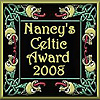
|
|
|
St. John's Eve in old Ireland, Part 2
by Bridget Haggerty
 The large communal fires of St. John's Eve were carefully tended so they would burn brightly long into the night. One of the favorite games for the youngsters was to snatch a burning stick from the fire and throw it high into the air — very exciting for the kids, but incredibly dangerous for the spectators! The large communal fires of St. John's Eve were carefully tended so they would burn brightly long into the night. One of the favorite games for the youngsters was to snatch a burning stick from the fire and throw it high into the air — very exciting for the kids, but incredibly dangerous for the spectators!
It was reported that John Millington Synge and his friend, Jack B. Yeats attended a St. John's Eve celebration on a visit to County Mayo in 1905. At first, they had been saddened by the depressed state of the area, but then Synge is quoted as saying: "...the impression one gets of the whole life is not a gloomy one. Last night was St. John's Eve, and bonfires - a relic of Druidical rites - were lighted all over the country, the largest of all being in the town square of Belmullet, where a crowd of small boys shrieked and cheered and threw up firebrands for hours together." Yeats remembered a little girl in the crowd, in an ecstasy of pleasure and dread, clutching Synge by the hand and standing close in his shadow until the fiery games were over.
Other customs included inviting the oldest woman in the area to go three times sunwise round the fire on her knees saying prayers, to ward off disease; in some localities, holy water was sprinkled on the fire and, as on other festivals, it was sprinkled on the house, its occupants, outbuildings, livestock and the crops. Generally, this was done by either the oldest person in the family, but in some parts of Ireland, the youngest child was asked to do it.
As might be expected, there was plenty of eating and drinking! Customarily, in Connaught, a special dish called "Goody" was made. This was white 'shop-bread' which had been soaked in hot milk and flavored with sugar and spices. It was usually made in a large pot that was either placed on the communal bonfire or heated on a smaller fire close by. Revelers brought their own spoons and bowls if they wanted to share in the "Goody."
In many parts of Ireland, it was the tradition for children to go around the village asking for "a penny for the bonfire." They used the money they collected to buy candy and cakes to eat that evening at the fire. Popular with the old folk was a few bottles of poitín (potcheen) or whiskey; the young men, on the other hand, would pool their resources and buy a barrel of beer or porter which was shared all around.
 When the communal bonfires were dying down, cows were often driven through them. Just so you don't think the Irish were being cruel to their livestock, the communal fire was often a pair of fires between which the cattle were driven to protect them against disease for a year.
When the communal bonfires were dying down, cows were often driven through them. Just so you don't think the Irish were being cruel to their livestock, the communal fire was often a pair of fires between which the cattle were driven to protect them against disease for a year.
Likewise, it was believed that the fire would protect all the crops grown on the farm, and that it could increase the yield, ensure a good harvest, and keep away blight, rust and other plant diseases. To make certain the fields were adequately protected, the fire had to be applied to the fields.
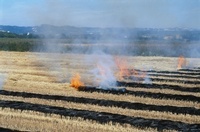
There were two ways this was done; many people took embers from the big fire and threw them into each field; if the growth of a crop was high enough to hide the glowing ember, this was thought to be a very good omen. The other way was for people to bring a long stemmed bush to the communal fire, light it, throw it into a crop or carry it through the fields. Many times, each member of a family would make individual torches which was lit from the fire and then carried high aloft as the family processed around every corner of their property. It must have been quite a sight to see from a distance, as neighboring families performed the same ritual!
Before moving on to the other customs surrounding the festival of St. John, there was one last ritual to perform and that was the bringing home of an ember from the communal fire and placing it on the family hearth. Some families also kept ashes from the fire for luck, others because they believed the ashes would ensure a peaceful death to old people who were ailing. The ashes also had curative powers: mixed with water, they were drunk to relieve internal disorders and they were used to cleanse and bathe wounds, sores and swellings.
After the merriment of St. John's Eve and with the fire burned out, families retired to their homes to rest up for the festivities of June 24th, the Saint's birthday!
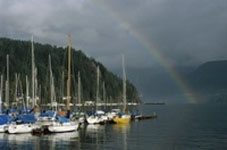 In the city of Limerick, they would have eagerly anticipated a colorful parade of tradesmen. Adorned with sashes, ribbons and flowers, and accompanied by musicians, they marched in groups through the principal streets. A similar procession took place in Galway City, except that the marchers were the fishermen of Claddagh village. They were all uniformly clad in an outfit that included a short white jacket, silk sash and a hat decorated with flowers. Each of them carried a long pole or staff on which was an emblem of their trade and two of them - usually the stoutest pair in the group - wore masks as well as hundreds of ribbons all over their outfits. These were the 'merrymen" or clowns of the day who performed tricks and antics along the route. At the head of the procession was a group of musicians who led the marchers through the streets and then wound their way around the city until they arrived back at the staring point. In the city of Limerick, they would have eagerly anticipated a colorful parade of tradesmen. Adorned with sashes, ribbons and flowers, and accompanied by musicians, they marched in groups through the principal streets. A similar procession took place in Galway City, except that the marchers were the fishermen of Claddagh village. They were all uniformly clad in an outfit that included a short white jacket, silk sash and a hat decorated with flowers. Each of them carried a long pole or staff on which was an emblem of their trade and two of them - usually the stoutest pair in the group - wore masks as well as hundreds of ribbons all over their outfits. These were the 'merrymen" or clowns of the day who performed tricks and antics along the route. At the head of the procession was a group of musicians who led the marchers through the streets and then wound their way around the city until they arrived back at the staring point.
In just about every fishing district, St. John's Day was important. In many places it was the day the boats and nets were blessed and there was many an angler living inland who eagerly anticipated the arrival of sea trout which entered the rivers at this time of year.
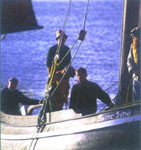 The Large crowds bent on fun and frolic would be attracted to these events which included the erecting of a decorated pole. This pole was once described as being "as lofty as the mast of a sloop" and on its top , a small basket of cakes or gingerbread and a bunch of garters were tied. The best musician attending the assembly was always selected to perform at the foot of the pole and the best dancers competed with one another for the honor of winning the prizes - a girl got the gingerbread and a fellow got the garters. The Large crowds bent on fun and frolic would be attracted to these events which included the erecting of a decorated pole. This pole was once described as being "as lofty as the mast of a sloop" and on its top , a small basket of cakes or gingerbread and a bunch of garters were tied. The best musician attending the assembly was always selected to perform at the foot of the pole and the best dancers competed with one another for the honor of winning the prizes - a girl got the gingerbread and a fellow got the garters.
Indeed, midsummer in Ireland was merry for most; however, there was sadness in west Ulster and west Connaught for this was the time of year when the menfolk went as migratory harvest workers to England and Scotland. Often, they would be gone until late fall or even early winter, which meant that the turf had to be saved and the potatoes earthed up before the migrants left. Overall though, it was a time of optimism, with farmers hoping they'd get a period of wet weather before St. John's Day and dry weather afterwards. Those who were ill hoped for improvement and it was generally believed that even the very sick, if they survived over midsummer, would live on at least until fall. As for the children, they hoped the cuckoo would eventually return, for it was about this time that the cuckoo ceased its call and the children were told it had flown away to Spain!
Click here for St John's Eve Part 1
|
|
Thu, Apr 4, 2024
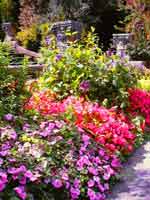 Ilnacullen, Co. Cork - an Island Garden Ilnacullen, Co. Cork - an Island Garden
Located in the sheltered harbour of Glengarriff in Bantry Bay. Ilnacullin, which means island of holly, is a small island known to horticulturists and lovers of trees and shrubs all around the world as an island garden of rare beauty.
The vivid colours of Rhododendrons and Azaleas reach their peak during May and June, whilst the hundreds of cultivars of climbing plants, herbaceous perennials and choice shrubs dominate the midsummer period from June to August.
Because of its sheltered situation and the warming oceanic influence of the Gulf Stream, the climate is favourable to the growth of ornamental plants from many parts of the world.
Even for those who aren’t particularly interested in gardens, there are many other scenic views, especially in the surrounding waters where seals frequent the rocks on the southern shore.
The cover photo on Bridget's book The Traditional Irish Wedding shows a wrought iron garden gate on Ilnaculen. I took that photo. To see it, go to the home page. It's part of the opening paragraph Failte.
—Russ
Resource: Copy and Image - Cork Guide
Click for More Culture Corner.
|
|




 Ilnacullen, Co. Cork - an Island Garden
Ilnacullen, Co. Cork - an Island Garden